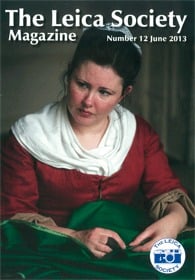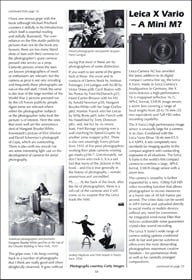Leica Society Magazine
This substantial book (some 280 pages) can be approached on two different levels, but by whichever approach you should find it rewarding. The book celebrates the photographer first and the camera second. It is about photography in the pre-digital 20th century; it show us a side of photographers we seldom see – their faces – and in this it is successfully fascinating.
A photographer is usually a name under a photograph – now we can put a face to many of these names. We are by nature curious about the people we admire and it is interesting to see what they look like; Robert Frank in a suit and tie, young Bruce Davidson, Edward Steichen, J-H Lartigue, and of course Andreas Feininger’s pictures of Dennis Stock that are on the cover, end-papers and elsewhere. I had the cover picture as a postcard on my wall for many years, so seeing the complete shoot is a real bonus. Many are much admired names; we know their photographs but we’ve never seen what they look like. It may not help us appreciate their photographs but it satisfies a certain curiosity in us all.
Some may same this is not important; indeed many photographers would agree and some have gone to great lengths not be photographed. We know that Henri Cartier-Bresson did not like being photographed and is usually seen peering over his M3, as in the strong picture by Dmitri Kessell on page 38, where we just see the eyes. But less familiar is the striking image of him by Arnold Newman on the facing page. So don’t forget that in many cases these pictures of other photographers at work are taken by the ‘greats’ themselves.
I can speculate a little, from my own experience, on how many of the pictures here came to be taken. Many are casual pictures of friends who happened also to be photographers; sometimes working on the same assignment and snapped at the end of a hard day – or at social gatherings to which photographers are much addicted. Press photographers always carry a camera wherever they go. There are few formal portraits, and few studio set-ups (except for the film company publicity shots, of which more later). Then there are the self-portraits by those who are happy to photograph themselves; many are delightful studies often humours and self-deprecating; look at those of Haas, Doisneau, Feininger, Eisenstaedt and Ronis with his cobbled-together lighting set-up. These are mostly spur-of-the-moment snaps often to use up film at the end of a shoot, and I’m sure that sadly many others have ended up in the bin.
It also cannot be denied that the anorak in all of us is fascinated to see what cameras these photographers were using. Don’t deny it! Indeed, seeing Paul Strand with his huge view camera, or Cecil Beaton coaxing the right expression from Andy Warhol, adds perspective when we see their photographs; Willy Ronis with his double Focas; Larry Burrows with his Nikons & Leicas; Bert Hardy with his Contaz II; and lots of wacky plate cameras with multiple flash guns; lots of long lenses, like Feininger – out of the studio – with his monster self-made very Long Tom. There are possibly too many shots of the press pack over the years, usually snatched during a press assignment, but they do show us how certain cameras evolved over the years. This is another laudable aspect of the book in that it is a commentary on the development of the equipment we all use today – over the last 100 years. It says a lot about how we got from cumbersome plate cameras of the early 1900s to the M3 and M2 – and aren’t we fortunate to have come in a at the tail-end of this development?
I have on serious gripe with the book (although Michael Pritchard counters it skilfully in his introduction, which itself is essential reading and skilfully illustrated). The over-reliance on the film studio publicity pictures does not do the book any favours; there are too many bland shots of stars with their cameras (or the photographer’s spare camera) pressed into service as a prop. Certainly pictures where the stars are known photographers of merit or enthusiasm are relevant; but the camera as prop is not very revealing and frequently these photographs are run-of-the-mill stuff. I think the same is also true of the large number of the World War 2 pictures pumped out by the US Forces publicity people. Again some are relevant where either the photographer (subject) or the photographer (who took the picture) is of interest. Here the ones that work well are the anonymous shot of Margaret Bourke-White, Eisenstaedt’s picture of Eliot Elisofon and David Scherman’s photograph of Capa, which are outstanding. There is also (with my anorak hat on) some interesting light cast on the development of cameras for aerial photography.
This gripe over, I do keep coming back to a number of photographs that I think are really good and often delightfully observed. It goes without saying that most of these are by photographers of some distinction.
If you want to see some of the gems look at these: the cover and its contacts of Dennis Stock by Andreas Feininger; J-H Lartigue with his Illf by Victor Drees p28; Cecil Beaton with his Pentax by Fred McDarrach p31; Henri Cartier-Bresson with his M3 by Arnold Newman p39; Margaret Bourke-White with her large Graflex p60; Martine Franck with her Leicas by Willy Ronis p69; John French with his Hasselblad by Terry Donovan p85;and last, but by no means least, Fred Ramage jumping over a wall clutching his Speed Graphic by another press snapper p262. There is also one amazingly funny picture from 1935 of five press photographers working their plate cameras wearing gas masks p236-7. Unfortunately, we son’t know who took it. It is a sad fact that many of the pictures in this book – and this is true generally in the history of photography – remain anonymous and uncredited.
PS… At the back of the book, after the list of photographers, there is a roll-call of the cameras and it will come as no surprise that the Leica leads the field.









